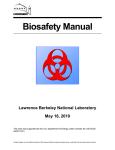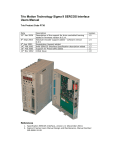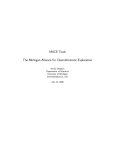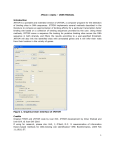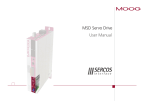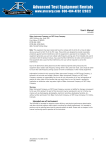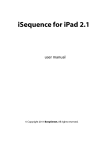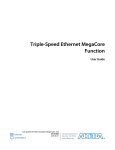Download BioWord User Manual
Transcript
BIOWORD: USER MANUAL
INSTALLATION:
AUTOMATIC INSTALLATION:
1) Open BioWord.dotm by right-clicking the file icon and clicking “Open.” Alternatively, you can open
the file from within Microsoft Word.
Do NOT double-click the file icon. BioWord is a template, which will by default open behind a
new document.
Make sure ‘BioWord’ is printed at the top of Microsoft Word—NOT ‘Document'.
CORRECT
INCORRECT
Word
2) Double-click the “Click to Install BioWord” button in the document.
3) Follow the Installation prompts.
NOTE: If Word is installed in a non-default location, installation must be manual.
MANUAL INSTALLATION
The BioWord.dotm file needs to be placed in the Microsoft Word STARTUP folder so that the toolbar is
available for every document. The path to this folder is listed below:
For Windows XP:
C:\Documents and Settings\<Username>\Application Data\Microsoft\Word\Startup
For Windows Vista/7:
C:\Users\<Username>\AppData\Roaming\Microsoft\Word\STARTUP
MACRO SECURITY
In order to use BioWord, you may need to change your macro security settings
1) Click the circular Word button in the upper left-hand corner
2) Go to Word Options at the bottom right of the menu
1
3) Click the Trust Center on the left hand menu
4) Click the button marked Trust Center Settings
5) Make sure “Enable all macros…” is selected (the last option)
SELECTION:
BioWord can recognize sequences entered in raw, GenBank, and FASTA format.
Raw and GenBank sequences must be separated by two enters.
If any sequences are entered in FASTA format (with a > denoting the header), the > will be
used to separate sequences rather than two enters.
To perform an operation, simply select the sequence(s) you are interested in.
There are DNA/RNA-specific operations, protein-specific operations, and operations that can be
performed on any type of sequence. BioWord will only perform an operation on appropriate selected
sequence(s). For example, if a DNA sequence and protein sequence are both selected for a DNA/RNAspecific operation, the operation will be performed only on the DNA sequence.
GLOBAL OPTIONS
BASIC OPTIONS
Default Output
Raw – your results will be displayed in the raw format
FASTA – your results will be displayed in the FASTA format (if a header was not provided, a
numbered default one will be created)
GenBank – your results will be displayed in the GenBank format
Default Output Location
Append to Document – your results will be printed beneath the selection
Create New Document – your results will be printed on a new Document
Save to Clipboard – your results will be saved to the Clipboard; use Paste (Ctrl + V) to retrieve
them (note that this option limits formatting)
Replace Selection – your results will overwrite the selection
2
ADVANCED OPTIONS (POP-UP)
%ATCG
This is the value used to determine what composition of bases defines a DNA/RNA sequence
(for RNA, T is replaced by U). It should be entered as an integer percentage (i.e., 70 rather
than .70).
If the “Allow IUB characters” option is selected, the sequence will be considered DNA/RNA
irrespective of %ATCG if no non-IUB characters are found in the sequence.
Precision
All numerical results will be printed to this number of decimal places
Allow IUB characters
If this option is selected, the following characters will be allowed in DNA/RNA sequences:
A, T/U, C, G, N(ATCG), V(GAC), B(GTC), H(ATC), D(GAT),
K(GT), S(GC), W(AT), M(AC), Y(CT), R(AG)
All other characters will be filtered out.
If this option is not selected, only A, C, T/U, G will be allowed in DNA/RNA sequences.
All other characters will be filtered out.
Ex) If AGGATCGAMMA were selected, AGGATCGAA would be processed.
Wrap FASTA Text
If this option is selected, FASTA sequences will be wrapped every 90 characters when printed
Pseudocounts
What are pseudocounts?
A pseudocount is a number that can be added to a quantity that is known to be non-zero. In a
sequence motif for example, a zero frequency of a base at a certain position could simply be
due to too small a dataset. A pseudocount accounts for and corrects this possibility.
How are they calculated?
BioWord offers two methods of calculating pseudocounts. Below are the formulas used for
each:
LaPlace’s Rule:
where M is the number of
alphabet size and N is the number
of sequences
10-50:
Use this option to avoid taking the
log of 0
3
Where are they used?
The pseudocounts are used for Position Specific Frequency Matrix (PSFM) calculations. A
PSFM is generated for the following operations:
Search
Dyad Pattern Search
Consensus Logo
Gibbs Sampling
Greedy Sampling
Information Content
What is Information Content (IC)?
Information Content is a value that quantifies the difference between the position-specific
frequencies of a motif and a uniform or background distribution.
How is it calculated?
BioWord offers two method of calculating IC: Shannon Entropy (also called Rsequence) and
Relative Entropy. Shannon Entropy concerns uncertainty, or how predictable a motif is given
the expected distribution. Relative Entropy puts more emphasis on the background
distribution: comparing the background entropy with the entropy of the motif. Below are the
formulas used to calculate each:
Rsequence
(Shannon Entropy)
where fs is the
expected frequency of
base s in the genome
and ps,i is the
frequency of base s in
position i in the motif
Relative Entropy
where fs is the
expected frequency of
base s in the genome
and ps,i is the
frequency of base s in
position i in the motif
Where is it used?
The calculated IC values are used for the following operations:
Search
Dyad Pattern Search
Consensus Logo
Gibbs Sampling
Greedy Sampling
4
Search Scoring Function
What is a scoring function?
A scoring function can be used to search for a particular site in a sequence when given a
sequence motif (the query) and some background genomic information. Higher scoring results
are better matches.
How is it calculated?
BioWord offers two scoring functions: Ri sequence and Isequence. Ri sequence is derived from the
information content equation Rsequence, and Isequence is derived from the Relative Entropy
equation. Below are the formulas used to calculate each:
Ri Sequence
where fs is the expected
frequency of base s in the
genome and ps,i is the
frequency of base s in
position i in the motif
Isequence
where fs is the expected
frequency of base s in the
genome and ps,i is the
frequency of base s in
position i in the motif
Where is it used?
The scores calculated from these functions are used for the following operations:
Search
Dyad Pattern Search
Gibbs Sampling
Greedy Sampling
Protein Scoring
Scoring Matrix
BLOSUM 62
PAM 250
PAM 120
BLOSUM 50
GONNET
5
The selected scoring matrix will be used primarily for alignments of protein sequences.
However, if the check box “use this instead of mismatches” is selected, the selected scoring
matrix will be used to score results for the following operations:
Substring Search
Gapped Substring Search
Dyad Motif Discovery
If the checkbox is not selected, your results will be scored simply by the number of
mismatches.
Protein Background Frequencies
Uniform-a uniform distribution; yields background entropy of log2(20) = 4.32 bits
BLOSUM62 Frequencies-the distribution of amino acids used to create the BLOSUM62
matrix. Data can be found at http://selab.janelia.org/publications/Eddy-ATG2/lambda.c
TOOLS:
ADD COMMENTS
This function allows the user to add notes about a sequence or site. Select the text to which would
like the comment to refer, and then click the “Add Comment” button on the Ribbon.
Comments can be removed by selecting the sequence and clicking “Remove Formatting” on the
Ribbon, or by right-clicking on the comment bubble and selecting “Delete Comment”
REMOVE FORMATTING
Several of BioWord’s search operations can highlight matching sites in the sequence. To remove
any highlighting or text coloration from a sequence easily, select the sequence(s) and then click the
“Remove Formatting” button on the Ribbon. As mentioned above, the “Remove Formatting”
operation will also remove any comments that have been entered.
BIGGER/SMALLER
These text-size manipulation buttons are useful when generating Consensus Logos, as when a logo
is originally printed, the text can be quite small. To increase the size of the logo while maintaining
proportions, select the logo and click the “Bigger” button on the Ribbon until the size is acceptable.
Similarly, the “Smaller” button can be used to shrink the text of a logo without disrupting the
proportions.
6
MANIPULATION:
RAW
The raw format consists of the genetic sequence in plain text, with multiple sequences separated
with two enters. By clicking the “Raw” button on the Ribbon, any selected sequences will be
printed in the raw format. An example of a sequence in the raw format is shown below:
ATGATTTACCTGAAGTCCTTACTCAATGTTATTGATAATAGCGGGGCCCAGGTTGTCGAGTGTATCAAGGTCCTGCGG
CATAAGCCGAAGTCCTGTGCTCAGATTGGTGATCGTATTACCTGTGTCGTTAAGCAGGCGCGCCCCTTACAGCAGGAG
CTCACCGGTCAGTCGTCCACCAATCGTGTCAAGCGTCGCGATATCTGTCAGGCCGTCGTTGTCAGAACCCGCGCTCCG
CTTAAGCGCAAGGATGGTAGCGTCGTGAGGTTTGATGATAATGCCTGTGTCCTCATCAATAAGAATGGCGAGCCCCTC
FASTA
The FASTA format precedes each genetic sequence with a header. A header begins with the >
character, and is separated from the sequence itself with a single enter. There is no restriction as
to the characters that may be included in a header. In BioWord, a FASTA sequence is defined as all
characters from the new-line after the header until the next > character, denoting another FASTA
sequence. An example of a sequence in FASTA format is shown below:
>gi|17544719:1391233-1391883 Ralstonia solanacearum GMI1000, complete genome
TTATGGAGCGGCTGGCCGGATCAGGCCGACCGCCAGTCCTTCCAACTGGAACTCGTCGCGGTCGAGATCGACGTGGATG
GGTTCGAAATCAGGGTTCTCGGCAATCAGCTCGACCTGCCGGCCTTTGCGCTGAAAGCGCTTAACCGTGACATCATCGC
CCAGCCGCGCAACGACGATCTTGCCGTTGGCGGCCTCGGCGGCGCGCTGTACCGCGAGCAGGTCGCCGTCGAGGATGCC
GGCATCGCGCATGCTCATGCCGCGCACTTTCAACAGGAAATCCGGCCGACTGGAAAACAGGGAAGGGTCGACCTGGTAT
TGCCGGTCGATGTGCTCGGCTGCCAGGATCGGGCTACCCGCCGCAACGCGGCCCACCAGCGGCAGCGTCAGCTGCATCA
GCCCCATCGACGGCAGCGAGAACTGGTGCGGCGATGCGCCGCCCTCCGCGCGCAGCCGGATACCGCGTGATGCGCCGGG
CGTCAGCTCGATCACGCCCTTGCGGGCGAGTGCCCGCAGGTGCTCCTCGGCCGCATTCGGCGACGAGAAGCCGAACTCC
By clicking the “FASTA” button on the Ribbon, any selected sequences will be printed in the FASTA
format. You will be prompted to enter a header for your selected sequence(s). If multiple
sequences are selected, the header you enter (plus a unique number to differentiate) will be used
for all selected sequences. If a header is not entered, a default header of the form > Seq # will
be generated for each sequence.
GENBANK
The GenBank format prints genetic sequences with 60 characters per line (6 groups of 10
characters, each group separated by a space). Each line is preceded by a number denoting the
position of the first base in that line. Multiple GenBank sequences should be separated by two
enters. By clicking the “GenBank” button on the Ribbon, any selected sequences will be printed in
the GenBank format. An example of a sequence in GenBank format is show below:
1 TTATGGAGCG GCTGGCCGGA TCAGGCCGAC CGCCAGTCCT TCCAACTGGA ACTCGTCGCG
61 GTCGAGATCG ACGTGGATGG GTTCGAAATC AGGGTTCTCG GCAATCAGCT CGACCTGCCG
121 GCCTTTGCGC TGAAAGCGCT TAACCGTGAC ATCATCGCCC AGCCGCGCAA CGACGATCTT
7
REVERSE
This function reverses any selected sequence(s). It can be performed on both DNA/RNA and
protein sequences. Below is a simple example:
>test sequence
TTATGGAGCGGCTGGCCGGATCAGGCCGACCGCCAG
>test sequence
GACCGCCAGCCGGACTAGGCCGGTCGGCGAGGTATT
COMPLEMENT
This function complements any selected sequence(s). It can only be performed on DNA/RNA
sequences. If IUB characters are included (and allowed), they will not be affected by taking the
complement. Below is a simple example:
>test sequence
TTATGGAGCGGCTGGCCGGATCAGGCCGACCGCCAG
>test sequence
AATACCTCGCCGACCGGCCTAGTCCGGCTGGCGGTC
REV. COMP.
This function takes the reverse complement of any selected sequence(s). It can only be performed
on DNA/RNA sequences. If IUB characters are included (and allowed), they will not be affected by
taking the reverse complement. Below is a simple example:
>test sequence
TTATGGAGCGGCTGGCCGGATCAGGCCGACCGCCAG
>test sequence
CTGGCGGTCGGCCTGATCCGGCCAGCCGCTCCATAA
TRANSLATION:
GENERAL OPTIONS (POP-UP)
Genetic Code
Standard
Vertebrate Mitochondrial
Yeast Mitochondrial
Mold, Protozoan and Coelenterate Mitochondrial
Invertebrate Mitochondrial
Ciliate, Dasycladacean and Hexamita Nuclear
Echinoderm and Flatworm Mitochondrial
Euplotid Nuclear
8
Bacterial, Archaeal and Plant Plasmid
BioWord allows the user to perform translations (codon -> amino acid) and reverse translations
(amino acid -> codon) according to the nine genetic codes listed above.
FORWARD
This operation translates a DNA sequence into an amino acid sequence according to the selected
genetic code. Only DNA sequences may be translated. If IUB characters are allowed, it is possible
that multiple amino acids could satisfy a degenerate codon. BioWord will randomly select one of
the possible amino acids. Remember if IUB characters are not allowed, they will be stripped from
your sequence prior to the translation. This could interfere with the translation frame. Any
“leftover” DNA bases (if the sequence length is not a multiple of 3 based on the offset) will be
ignored.
Offset
0
1
2
The offset determines the reading frame for the translation.
0
1
2
ATC | GAG | GGC | CCG | A…
A | TCG | AGG | GCC | CGA…
AT | CGA | GGG | CCC | GA…
Below is a simple translation example, with the Standard Genetic Code and an offset of 0:
>test sequence
TTATGGAGCGGCTGGCCGGATCAGGCCGACCGCCAG
>test sequence (translated)
LWSGWPDQADRQ
REVERSE
This operation reverse translates an amino acid sequence into a DNA sequence according to the
selected genetic code and method of reverse translation (described below). Only protein
sequences can be reverse translated; an error message will be generated for any DNA/RNA
sequences and they will be ignored.
Uniform
If the uniform option is selected, a random DNA codon will be selected from all of those that code
for a given amino acid. Each codon has an equally likely chance of being selected.
9
>test sequence
LWSGWPDQADRQ
>test sequence (back translated)
CTTTGGTCGGGGTGGCCCGATCAGGCCGATAGACAG
IUB
If the IUB option is selected, each amino acid will be reverse translated into a single codon of
degenerate IUB characters (according to the degenerate codons that code for that amino acid).
>test sequence
LWSGWPDQADRQ
>test sequence (back translated)
YTNTGGWSNGGNTGGCCNGAYCARGCNGAYMGNCAR
Best
If the best option is selected, the most frequently occurring DNA codon will be used for a given
amino acid. The most frequently occurring codon will be determined by a codon usage table,
which much be pasted into the prompt box. Codon usage tables in the proper format are available
at http://www.kazusa.or.jp/codon/ using the option “a style like CodonFrequency output in GCG.”
Note that the prompt specifies NOT to include the column headings. This refers to the line
highlighted in red below that is displayed on the above webpage.
AmAcid
Gly
Gly
Gly
Gly
Codon
GGG
GGA
GGT
GGC
Number
0.00
1.00
0.00
10.00
/1000
0.00
2.06
0.00
20.58
Fraction
0.00
0.00
0.00
0.00
..
>test sequence
LWSGWPDQADRQ
>test sequence (back translated)
CTTTGGTCAGGCTGGCCTGATCAAGCTGATCGTCAA
Random Best
If the random best option is selected, the DNA codon for a given amino acid will be selected
randomly via a weighted probability distribution function. Each codon is given a range of size
proportional to its frequency as determined by a codon usage table. As described above, codon
usage tables in the proper format are available at http://www.kazusa.or.jp/codon/using the option
“a style like CodonFrequency output in GCG.”
>test sequence
LWSGWPDQADRQ
>test sequence (back translated)
CTTTGGTCAGGCTGGCCTGATCAAGCTGATCGCCAG
10
MAP
The translation map uses the selected genetic code to generate forward translations of a selected
DNA sequence for every offset (0, 1, and 2). It handles IUB characters and leftover bases in the
same manner as the forward translation operation. Each line is numbered with the position of the
first base/amino acid in that line.
>test sequence
TTATGGAGCGGCTGGCCGGATCAGGCCGACCGCCAGATAGAGCCGGTACTCAACCCCCG
>test sequence
1
M E R L A G S G R P P D R A G T Q P P
1 Y G A A G R I R P T A R * S R Y S T P
1 L W S G W P D Q A D R Q I E P V L N P
1 TTATGGAGCGGCTGGCCGGATCAGGCCGACCGCCAGATAGAGCCGGTACTCAACCCCCG
DNA STATISTICS:
FREQUENCIES
This operation calculates the frequencies of A, U/T, C and G in a DNA sequence. IUB characters are
not included in the base frequencies, but ARE included in the total length of the sequence.
>test sequence
TTATGGAGCGGCTGGCCGGATCAGGCCGACCGCCAGATAGAGC
Mononucleotide Frequencies
Nucleotide
test seque
A
U/T
C
0.209
0.140
0.279
G
0.372
N-GRAM
The N-gram is a frequency representation of a DNA sequence. In essence, the DNA N-gram is
generated by computing the histogram of the absolute frequencies of each N-nucleotide (di-, tri-,
tetra-nucleotide). The N-grams will be listed in alphabetical order.
If IUB characters are allowed, any N-gram that contains an IUB character is not recorded in the
counts. For example, for the sequence AATRRTC with an n-gram of 2, AA, AT, and TC would be
recorded with counts of 1. TR, RR, and RT are ignored. If IUB characters are not allowed, the
sequence would be read as AATTC and AA, AT, TT, and TC would be recorded with counts of 1.
Only display N-Grams in the sequence
If this option is selected, instead of listing every possible N-nucleotide, only those that are found in
the sequence will be listed.
11
Include reverse complement
If this option is selected, the counts from the reverse complement of the selected sequence will be
included in N-gram results.
Below is an example with N = 3, the “only display N-Grams in the sequence” option is checked and
the “include reverse complement” option is not checked.
>test sequence
ATGATGGATGGCTATG
NGram (3) for Seq 'test sequence'
NGram
ATG
CTA
GAT
GCT
GGA
GGC
TGA
TGG
Count
3
1
2
1
1
1
1
2
%GC GLOBAL
This operation calculates the %GC content of an entire selected DNA/RNA sequence. If IUB
characters are allowed, they are included in the length of the sequence but not in the GC count.
>test sequence
TTATGGAGCGGCTGGCCGGATCAGGCCGACCGCCAGATAGAGC
%GC Content -> Global
Position
0
test seque
0.651
%GC WINDOW
This operation computes %GC content by using a sliding window of a defined length. If IUB
characters are allowed, they are included in the length of the sequence but not in the GC count.
Generate graph
If this option is selected, BioWord will generate a Microsoft Chart object graphing the %GC
content as a function of window start position. If multiple sequences are selected, all will be
graphed as different series on the same graph.
Length
Length is the size of the window over which %GC is computed.
Step-size
Step-size is how many bases the window skips when it is slid to the next position. A step-size of
one will compute the %GC of a window starting at position 0, then at position 1, etc. A stepsize of 5 will compute the %GC of a window starting at position 0, then at position 5, etc.
12
Below is an example with a window length of 10 and a step size of 1:
>test sequence
ATGATATGGCTATG
%GC Content -> Window Length: 10
Step Size: 1
Position
test seque
0
0.400
1
0.400
2
0.400
3
0.300
4
0.400
This example generates a graph for %GC on a longer sequence. This has a window length
of 10 and a step size of 1:
>Seq 0
ATGCCAGGAATTCCCGGGGATCCTCCATCGGCGGAGTGTCGATGGACAGCGACCTCCGCCAGGAGATCATCCTCAAACCTTCCCGGA
CCCTCCCACCCCTAA
1
0.8
0.6
GC Content
0.4
0.2
0
Seq 0
0
20
40
60
80
100
Position
CODON USAGE TABLE
This operation generates a codon usage table according to a DNA sequence. It parses the
sequence into codons, calculates frequency statistics, and uses the selected genetic code to
determine corresponding amino acids. The codon usage table is printed in the “CodonFrequency
output in GCG” format as found on http://www.kazusa.or.jp/codon/.
Offset
0
1
2
The offset determines the reading frame for identifying the codons.
Printing Options
Table – Results are printed as a Microsoft Word table object with cells/borders.
Whitespace – Results are formatted using tabs and returns rather than as an actual table
13
MOLECULAR WEIGHT
This operation calculates the molecular weight (in amu) of a DNA/RNA sequence. IUB characters, if
allowed, are assigned an approximate weight according to the type of nucleic acid.
DNA
Double-stranded – Includes the weight of the sequence’s complement strand
Include 5’-monophosphate – Adds 79 amu to each strand’s weight
RNA
Include 5’-triphosphate – Adds 159 amu to the strand’s weight
PROTEIN STATISTICS:
GENERAL
This operation calculates general frequency statistics for a protein sequence. It enumerates each
individual amino acid as well as the sequence’s composition of aliphatic, aliphatic hydroxyl,
aromatic, sulfuric, basic, and acidic amino acids.
GRAVY
The GRAVY value for a protein sequence is calculated as the sum of hydropathy values of all the
amino acids, divided by the number of residues in the sequence.
ISOELECTRIC POINT
The isoelectric point of a protein sequence is the pH at which the protein does not have a net
electric charge. The algorithm that BioWord uses can be found here (the bisection method):
http://isoelectric.ovh.org/files/practise-isoelectric-point.html
MOLECULAR WEIGHT
This operation calculates the molecular weight (in amu) of a protein sequence. It is calculated by
summing the average isotopic masses of amino acids in the protein and the average isotopic mass
of one water molecule.
SUBSTRING SEARCHES:
ORFS
This operation finds open reading frames (ORFs) in a DNA sequence. An ORF begins with a start
codon (BioWord accepts ATG, CTG, GTG, and TTG as start codons) and terminates with a stop
codon (TAG, TAA, and TGA). BioWord will optionally search the reverse complement of a
sequence for ORFs as well. If the Replace Selection option is selected, the optimal ORF will be
highlighted in the sequence (if the ORF was in the original sequence, the highlight will be yellow; if
14
it is in the reverse complement of the sequence, the highlight will be green.) If the Below Selection
or Save to Clipboard option is selected, the frame, positions of the start and stop codon for the
optimal ORF, its length in codons, and its sequence will be printed. If the New Document option is
selected, all ORFs found in the selected sequence will be displayed.
Minimum Codon Length
The minimum codon length is the length threshold for an ORF. It includes the stop and start
codons.
Include Reverse Complement
If this is selected, the reverse complement of the sequence will also be searched for ORFs. Any
ORFs found in the reverse complement will be marked as such in the output.
Optimization
CAI + Length – If this option is selected, the ORFs are optimized by their CAI score times and
their length in codons. CAI stands for Codon Adaptation Index and is a measure of codon bias
according to a defined set of genes. This gene set is defined with a codon usage table. Codon
usage tables in the proper format are available at http://www.kazusa.or.jp/codon/ using the
option “a style like CodonFrequency output in GCG.”
Length—If this option is selected, the ORFs are optimized by their length in codons.
The example below is optimized by length. The highlighted sequence was generated with the
Replace Selection option and the printed results were generated with the Below Selection option.
>test sequence{Longest ORF: Start=2; Stop=103; Length=34;
Frame=1}
AATGCCAGGAATTCCCGGGGATCCTCCATCGGCGGAGTGTCGATGGACAGCGACCTCCGC
CAGGAGATCATCCTCAAACCTTCCCGGACCCTCCCACCCCTAAAAACAGATTTCTGTTTC
Longest ORF for 'test sequence'
Start Codon Pos: 2
Stop Codon Pos: 103
Length (in codons): 34
ATGCCAGGAATTCCCGGGGATCCTCCATCGGCGGAGTGTCGATGGACAGCGACCTC
CGCCAGGAGATCATCCTCAAACCTTCCCGGACCCTCCCACCCCTAA
SUBSTRING/GAPPED
BioWord has two options for string searching – Substring Search and Gapped Search. The gapped
search allows the user to search for two strings separated by a gap of a defined length. The score
of a gapped search match is the sum of the scores of the two strings.
For DNA/RNA sequences, the number of mismatches between the query sequence and selected
sequence is calculated and used to judge the suitability of the match. If IUB characters are allowed,
their mismatch penalties are calculated using weighted probabilities. For example, the IUB base R
15
could be either A or G. If R is scored against A, it will have a mismatch penalty of 0.5. If R is scored
against W (A or T), it will have a mismatch penalty of 1 – P(R, A) * P(W, A) = 0.75.
For protein sequences, there are two scoring methods. The desired scoring method is indicated in
the Advanced Options menu. If the checkbox “use this instead of mismatches” is selected, the
scoring matrix from the drop-down will be used to score (higher scores correspond to better
matches). If the checkbox is not selected, a mismatch penalty system similar to DNA will be used.
There are two different ways to display results. If the Replace Selection option is selected, any
matches will be highlighted in the sequence; the darker the highlight, the better the match. If any
other output location is selected, the matches and their start position in the sequence will be
printed in a table, ordered with better matches first.
Mismatch Threshold
This option allows the user to define a maximum threshold for mismatches. If a substring of the
sequence has a higher mismatch penalty than the threshold, it will not be included in the results.
Score Threshold
This option allows the user to define a minimum threshold for a score if a protein sequence is
selected and the “use this instead of mismatches” checkbox is selected. If a substring has a lower
score than the threshold, it will not be included in the results.
Below is an example of a Substring Search for TATAT with a mismatch threshold of 1. The
highlighted result was generated when Replace Selection was selected and the tabulated result was
generated when Below Selection was selected.
> test sequence
ATGCATATTCGGGCATATAGCGTATCTCTGATAAGCTATATGGG
Matches for 'test sequence'
Match
TATAT
TATAG
TATCT
CATAT
CATAT
TATAT
Start Position
37
16
23
14
4
Mismatches
0
1
1
1
1
SITE SEARCH:
GENERAL OPTIONS
%GC Genome
This value is used to compute background DNA/RNA nucleotide frequencies for calculating Isequence
and Ri sequence scores. It should be entered as an integer value. A 40% GC value implies a genome
with 30% A, 30% T/U, 20% G and 20% C.
16
There are two options for background amino acid frequencies: a uniform distribution or the
BLOSUM62 distribution. This is indicated in the Advanced Options menu.
Maximum Results
This value is used to limit the number of results printed.
IC Threshold
This option is used to define a score threshold, which is the value entered in the input box will be
multiplied by the information content (IC) of the motif. Only results with an Isequence or Ri sequence
score that is greater than the score threshold will be reported.
SEARCH
This operation uses a motif to search a selected sequence. It can be performed on both DNA/RNA
and protein sequences. The sequences entered in the motif must be the same type and length and
should be in FASTA format or separated by two enters. The scores are computed using Ri sequence
or Isequence, whichever is selected in the Advanced Options menu.
This operation generates a PSFM for the motif. IUB characters, if allowed, are factored into the
PSFM based on weighted probabilities. For example, an R at a given position will increase the A
count by 0.5 and the G count by 0.5.
If the Replace Selection option is selected, the matches will be highlighted in the sequence, with a
darker highlight corresponding to a higher scoring match. If any other output location option is
selected, the results, their positions in the sequence, and their scores will be listed in a table.
The example below uses the motif PGIP, PGCP, PGMP, PGIP, PGIP to search the selected
sequence. The IC threshold is 0.3 X IC and the scoring function is Ri sequence. The highlighted
result was generated with the Replace Selection option selected and the tabulated results were
generated with the Below Selection option selected.
> test sequence
LPGIPGDPPSAECRWTATSARRSSSNLPGMPSHP
Results for 'test sequence'
Result
Start Position
IC Threshold: 4.389
Ri Score
PGIP
2
16.072
PGMP
28
14.487
DYAD PATTERN
This operation uses a dyad motif to search a sequence. The two components of the dyad may be
separated by a gap of defined length. The sequences entered in the motif must be the same type
and length and should be in FASTA format or separated by two enters. The scores are computed
using Ri sequence or Isequence, whichever is selected in the Advanced Options menu. The score of a
match is the sum of the scores of the two components.
17
This operation generates a PSFM for the motif. IUB characters, if allowed, are factored into the
PSFM based on weighted probabilities. For example, an R at a given position will increase the A
count by 0.5 and the G count by 0.5.
If the Replace Selection option is selected, the matches will be highlighted in the sequence, with a
darker highlight corresponding to a higher scoring match. If any other output location option is
selected, the results, their positions in the sequence, and their scores will be listed in a table.
Inverted Repeat/Direct Repeat Motif
This option determines the second half of the dyad. If the inverted repeat option is used, the
second half will be scored using the reverse complement of the motif. If the duplicate repeat
option is used, the second half will be scored using the same motif.
Below is an example using the motif TATG, TATC, TAAT, TTTC, TAGT, TATC, TATC with a gap ranging
from 2-3 bases. The inverted repeat option is selected. The IC threshold is 0.3 X IC and the scoring
function is Ri sequence. The highlighted result was generated with the Replace Selection option
selected and the tabulated results were generated with the Below Selection option selected.
>test sequence
CTGTATCTTGATATTATTTCCGGTATCAAAGAAAGTAAG
Matches for 'test sequence'
(inverted repeat)
Match
Start Position
Ri Score
TATCttGATA
4
12.9696516588714
TATCaaaGAAA
24
10.3846891581503
LOGO
This operation generates a consensus sequence logo for a sequence motif. A consensus logo is a
visual representation of a motif. The base at each position is the base that occurs most frequently.
The height of the bases is proportional to the position’s conservation/information content. The
motif’s information content is also printed at the end of the logo. Each sequence must be the same
length and of the same type. A consensus logo can be generated for both DNA/RNA sequences and
protein sequences.
There are two ways to input sequences to create a logo:
1. Select a sequence motif in the document and then clicking the Logo button on the Ribbon.
2. With nothing selected, click the Logo button on the Ribbon, and input the sequence motif
into the pop-up input box.
It is likely that the consensus logo will be printed at a very small font size. To scale the logo up or
down, select it and click the Bigger and Smaller buttons in the Tools group on the Ribbon.
18
This operation generates a PSFM for the motif. IUB characters, if allowed, are factored into the
PSFM based on weighted probabilities. For example, an R at a given position will increase the A
count by 0.5 and the G count by 0.5.
Use IUB/Epsilon:
This is a DNA/RNA specific option. If two or more bases have frequencies within epsilon at a given
position and this option is selected, the appropriate IUB character will be used in the consensus
logo. If this option is not selected, the first encountered equiprobable base will be used in the logo.
Include PSFM
If this option is selected, a PSFM will be printed along with the logo. PSFMs can be printed in
two formats:
Tabular PSFM—If this option is selected, a PSFM will be printed in a table format with
columns for the alphabet letters and rows for the positions.
Jaspar Matrix—If this option is selected, a PSFM as used by the Jaspar database will be
printed. The Jaspar matrix format is as follows, with each number representing the
amount of times that base was found in that position:
A
[13 13
3
C
[13 39
5 53
G
[17
2 37
0
0 52
3
T
[11
0
0
0
0 52
9
1 54
0
1
1
1
0
1 50
1
0 37
0
0 53
1
3
2
5 ]
0 17 ]
8 37 12 ]
6 15 20 ]
Scale (bits)
This value defines the size (in bits) of the vertical reference line that precedes consensus logos.
The example below has Use IUB and Include PSFM (tabular) selected and has a scale of 2 bits.
Selected Motif:
TTTCTGGT
CCTATTGT
TCAATTGT
TCCATTGT
CTCATTGA
CCAATTGT
CCCATTGT
TCCATTGT
PSFM
1
2
3
4
5
6
7
8
A
0.000
0.000
0.250
0.875
0.000
0.000
0.000
0.125
C
0.500
0.750
0.500
0.125
0.000
0.000
0.000
0.000
|YC ATTGT
(2 bits)
C
19
G
0.000
0.000
0.000
0.000
0.000
0.125
1.000
0.000
T
0.500
0.250
0.250
0.000
1.000
0.875
0.000
0.875
[IC: 11.058 bits]
MOTIF DISCOVERY:
GIBBS/GREEDY SAMPLING
These operations find optimal motifs of defined length within a collection of sequences. The Gibbs
Sampling algorithm works by randomly selecting a substring of defined length from each sequence
in the collection, and adding them to a temporary motif. One sequence is excluded. The motif and
excluded sequence are scored against each other using Ri sequence or Isequence via a sliding window.
The scores are used to generate a cumulative distribution function. Once all valid positions in the
excluded sequence have been tested, a random number is generated to determine which window
of the excluded sequence will be added to the temporary motif for the next iteration. In Gibbs
Sampling, this window is randomly selected using the cumulative distribution function. In Greedy
Sampling, the window is the one found to have the highest score against the motif. The selected
window is added to a motif and another sequence is excluded. This continues until the algorithm
has repeated the specified number of times.
The entire process is repeated ten times, and the motif with the highest information content will be
kept as a result. The user can opt to generate multiple motifs; in this case, this process will be
repeated for each result. BioWord uses masking to improve the chances of finding
alternate/weaker motifs. Results will be ordered by information content. Please note that this
operation may take time to complete.
This operation generates a PSFM for the sample motifs. IUB characters, if allowed, are factored
into the PSFM based on weighted probabilities. For example, an R at a given position will increase
the A count by 0.5 and the G count by 0.5.
If the Replace Selection option is selected, the optimal motif will be highlighted in each sequence in
the alignment. If any other output location option is selected, the sequences that make up the
optimal motif and their positions in each sequence will be printed in a table.
%GC of Genome
This value is used to compute background DNA/RNA nucleotide frequencies for calculating Isequence
and Ri sequence scores. It should be entered as an integer value. A 40% GC value implies a genome
with 30% A, 30% T, 20% G and 20% C.
There are two options for background amino acid frequencies: a uniform distribution or the
BLOSUM62 distribution. This is indicated in the Advanced Options menu.
Number of Iterations
This value is the number of times to run the Gibbs/Greedy Sampling algorithm in the hopes of
discovering the best motif.
20
Window Length
This value is the length of the motif to search for in the collection. It must be less than or equal to
the length of the shortest sequence in the selected collection.
Maximum Results
This value is used to limit the number of results printed.
Masking Parameter
To ensure that all results are unique, BioWord masks the positions of each discovered motif in each
of the sequences. The masking parameter allows the user to additionally mask positions
surrounding the ones that define the start of the motif. For example, consider the following
parameters: window-length = 8, masking parameter=0.25. If the motif was found at position 20,
BioWord will also mask within 8 * 0.25 = 2 positions of 20. In this case, positions 18, 19, 20, 21 and
22 will be masked.
This Greedy Sampling example has a window length of 10 and was run 100 times. The highlighted
sequences were generated with the Replace Selection option (Greedy Sampling highlights in green
and Gibbs Sampling highlights in yellow) and the tabulated results were from the Below Selection
option.
MSGERCFGRICDKRSSPNAAEEHLKALARKGVIEIVSGASRGIRLLMEEEPSEGLPLIGRVAAGEPLLA
FKGIRAAQYHLEALEHAGAIRRVPGQARGIRLAGQGAQTRTAPVSEVARDDVLRLPVLGRVAAGLPIGDSMRDEGIF
MLKLTPRQAEILAFIHIEQSCNINPAFFHPQADYLLRVHGMSMKDVGIFDGDLLAVHTC
MKALTARQQEVFDLNAAEEHLKALARKGVLEIVSGASRGIRLLQEEEDGLPLVGRVAAGEPLLAQQHIEGHYQVDPS
MKPLTAREEGLPLIGQVAAGEPILAEQHVEGTYKVDPNMFKPQADFLLKVYGQSMKDIGILDGDLLAVHST
MTLSRNNNAKRGLQLSQRKVVAPAATSPAFELPLVGIVAAGRPVEAFQLSDMDGDFVAVHPQ
MLTRIKALEERGFIRRLPNRARALEVIRLPENRTDSNQQEKKVRENFSLPKAHNDVVELPLHGRIAAGLPIGD
Greedy Sampling Motif:
Sequence
Seq 0
Seq 1
Seq 2
Seq 3
Seq 4
Seq 5
Seq 6
IC = 32.8026088258276
Aligned
RVAAGEPLLA
RVAAGLPIGD
EILAFIHIEQ
RVAAGEPLLA
QVAAGEPILA
IVAAGRPVEA
RIAAGLPIGD
At Position
60
60
10
55
16
37
64
DYAD MOTIF
This operation searches a sequence for all dyad motifs of a defined length with a defined spacer.
The score of a match is the sum of the scores (or mismatches) of the two components. The
operation can be performed on DNA/RNA and protein sequences.
For DNA/RNA sequences, the number of mismatches between a perfect dyad and a potential dyad
from the sequence is calculated and used to judge the suitability of the match. If IUB characters are
allowed, their mismatch penalties are calculated using weighted probabilities. For example, the
21
IUB base R could be either A or G. If R is scored against A, it will have a mismatch penalty of 0.5. If
R is scored against W (A or T), it will have a mismatch penalty of 1 – P(R, A) * P(W, A) = 0.75.
For protein sequences, there are two scoring methods. The desired scoring method is indicated in
the Advanced Options menu. If the checkbox “use this instead of mismatches” is selected, the
scoring matrix from the drop-down will be used to score a potential dyad (higher scores correspond
to better matches). If the checkbox is not selected, a mismatch penalty system similar to DNA will
be used.
Dyad Length
This value determines the length of one component of the dyad to look for in the selected
sequence. BioWord allows the user to specify a range of dyad lengths.
Spacer Length
This value determines the length of the spacer to allow between dyad components. BioWord
allows the user to specify a range of lengths for the spacer.
Mismatch Threshold
This option allows the user to define a maximum threshold for mismatches. If a dyad motif found
in the sequence has a higher mismatch penalty (scored against a perfect dyad) than the threshold,
it will not be included in the results.
Score Threshold
This option allows the user to define a minimum threshold for a score if a protein sequence is
selected and the “use this instead of mismatches” checkbox is selected. If a dyad motif has a lower
score than the threshold (scored against a perfect dyad), it will not be included in the results.
Maximum Results
This value is used to limit the number of results printed.
Inverted Repeat/Direct Repeat
This option determines the desired sequence of the second half of the dyad. With the inverted
repeat option, the second half of the dyad will be judged against reverse complement of the first
half. With the duplicate repeat option, the second half of the dyad will be judged against the first
half.
Below is an example searching for dyads (direct repeat) with length 4 ± 1, separated by a spacer
with length 3 ± 1. The mismatch threshold is 2 and maximum results are limited to 6.
>test sequence
TACGAGATCATTACATTGCATATTTTAGGGATCTATGCTCATTGGGCTATATA
Dyads for 'test sequence'
(direct repeat)
22
Dyad
CATtaCAT
CATtgCAT
ATTgcatATT
ATTacATT
ATGctcaTTG
TAGGgatcTATG
Start Position
9
14
15
10
35
26
Mismatches
0
0
0
0
1
1
ALIGNMENT:
BioWord can align DNA/RNA and protein sequences using a global or local algorithm (see
respective sections for more details). For printing output, if the FASTA output format is selected,
the sequences will be printed separately in FASTA format with gaps corresponding to the calculated
alignment. However, if Raw or GenBank output formats are selected, BioWord will produce a more
BLAST -esque alignment output. For protein sequences, BioWord marks conservation groups with a
“+” symbol.
See http://www.cgl.ucsf.edu/chimera/docs/ContributedSoftware/multalignviewer/clustgroups.html for
a description of amino acid conservation groups.
GENERAL OPTIONS
Gap Opening Penalty (GOP)
This is the value associated with opening a gap in an alignment.
Gap Extension Penalty (GEP)
This is the value associated with extending a gap in an alignment.
Maximum Results
This value is used to limit the number of results printed.
DNA SPECIFIC OPTIONS
Match/Mismatch
This option allows the user to define the score assigned to a (string) match and of a (string)
mismatch. That is to say that A with A would be a match, and A with any character other than A
would be a mismatch.
Matrix Scoring
This option allows the user to be more specific with scoring. The values in the matrix correspond to
the score between two characters. If an IUB character is allowed and encountered, its score is 0
regardless of the other character.
23
GLOBAL (NEEDLEMAN-WUNSCH)
BioWord’s pair-wise global alignment is based on the Needleman-Wunsch algorithm. This method
attempts to align the entirety of both sequences. Global alignments are useful when both
sequences are similar on the whole. This function can be performed on both DNA/RNA and protein
sequences. Protein sequences are aligned using the scoring matrix selected in the Advanced
Options menu.
The example below uses the following values: GOP = -3, GEP = -2, match = 2, and mismatch = -1.
The output format is Raw.
>test 1
TGGTAGATTCTACCGAAACCCCAAATATATAGGTAGGGGGACGTTCGCGGATGGTATAGATGT
>test 2
GCCATCGGCCGGGTGAATTGCGAGTAATAAACCCCAAATATACAGCGGTACGGGGGGTATATATATAT
Global
Match=2; Mismatch=-1
GOP=-3; GEP=-2
1 ----T------GGTAGATT-CTACCGA--AACCCCAAATATATAGGTAGGGGGACGTTCG
|
||| ||| | |
| ||||||||||||| ||
|| |||
|
1 GCCATCGGCCGGGTGAATTGCGAGTAATAAACCCCAAATATACAGC----GGTACG---G
61 CGGATGGTATAGATGT
|| | |||| || |
61 GGGGTA-TATATATAT
LOCAL (SMITH-WATERMAN)
BioWord’s pair-wise local alignment is based on the Smith-Waterman algorithm. This method
attempts to find a local optimal alignment. Local alignments are useful when two sequences are
overall different, but are suspected to contain regions of similarity. This function can be performed
on both DNA/RNA and protein sequences. Protein sequences are aligned using the scoring matrix
selected in the Advanced Options menu. The position where the optimal alignment begins is added
to each sequence’s header.
The example below uses the following values: GOP = -3, GEP = -2, match = 2, and mismatch = -1.
The output format is FASTA.
>test 1
TGGTAGATTCTACCGAAACCCCAAATATATAGGTAGGGGGACGTTCGCGG
>test 2
GCCATCGGCCGGGTGAATTGCGAGTAATAAACCCCAAATATACAGCGGTACGGG
>test 1 {Local; Match=2; Mismatch=-1; GOP=-3; GEP=-2; Pos=2}
GGTAGATT-CTACCGA--AACCCCAAATATATAG--GTAGGGG
>test 2 {Local; Match=2; Mismatch=-1; GOP=-3; GEP=-2; Pos=12}
GGTGAATTGCGAGTAATAAACCCCAAATATACAGCGGTACGGG
24

























